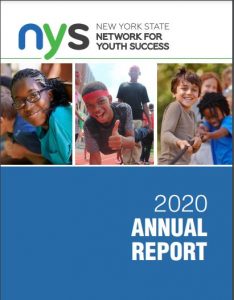History
The New York State Network for Youth Success: formerly AfterSchool Works! NY: the New York State Afterschool Network (ASW:NYSAN)
The New York State Network for Youth Success is the new, more inclusive name for the organization formerly known as AfterSchool Works! NY: the New York State Afterschool Network (ASW:NYSAN). This new name went into effect on May 1, 2016.
ASW:NYSAN was the combination of AfterSchool Works! NY and the New York State Afterschool Network. ASW:NYSAN was formed on June 1, 2015 to better serve the afterschool field in New York. The same work continues under the new name – the New York State Network for Youth Success.
AfterSchool Works! NY (ASW)
The organization formed as the New York State School Age Care Coalition in 1995. It became AfterSchool Works! New York (ASW) in 2008. ASW was the official state affiliate of the National Afterschool Association and served as a non-profit membership association for afterschool professionals in New York State. ASW administered the New York State School Age Care Credential, The New York State AfterSchool Accreditation Program, and an annual Training Institute. In addition, through an extensive network of intermediaries, training organizations and child care resource and referral agencies, it provided information, training, and support to afterschool professionals in order to build high-quality, sustainable afterschool programs that meet the needs of children, youth and their families.
The School Age Credential continues to promote quality services to children and families by providing specific standards, training and evaluation for afterschool professionals. Training for the credential is available via face-to-face programs that are offered by local host agencies as well as through a full distance learning model.
The New York State Afterschool Program Accreditation Model reflects the collective wisdom from the afterschool / youth development field and is modeled in part after the National Afterschool Association accreditation framework and the Quality Self-Assessment (QSA) Tool.
New York State Afterschool Network (NYSAN)
The New York State Afterschool Network began in 2001 as an advisory group to the New York State Education Department for the planning and implementation of the 21st Century Community Learning Centers (21st CCLC) program. In 2003, this advisory group formally became the New York State Afterschool Network (NYSAN) with the support of funding from the Charles Stewart Mott Foundation and fiscal sponsorship from ExpandED Schools (formerly TASC).
In 2008, NYSAN completed the Quality Self-Assessment (QSA) Tool, a nationally recognized tool to assist program staff, young people, parents, school leaders, and other stakeholders in building the capacity of their programs. The QSA Tool has been adopted by the New York State Education Department, New York State Office of Children and Family Services, New York City Department of Youth and Community Development, and many other groups across New York State and nationally.
The Network is now part of a national network of 50 statewide networks supported by the Mott Foundation. NYSAN grew to an organization with ten affiliated regional networks and hundreds of participating partner organizations statewide.
The work of the Network is made possible through the generous contributions of its public and private supporters, which currently include:
Charles Stewart Mott Foundation
Ralph C. Wilson Foundation
Rochester Area Community Foundation
Virginia and Harry Taylor Designated Fund of the Community Foundation for the Greater Capital Region
Hunger Solutions NY
STEM Next
Overdeck
Because of the legacy of ASW and NYSAN, The Network is the only statewide organization in New York State that brings together public and private sector leaders around a common agenda focused on building a high-quality system of expanded learning opportunities (ELOs) that support all young people in New York State in achieving success in school, work, and life.

